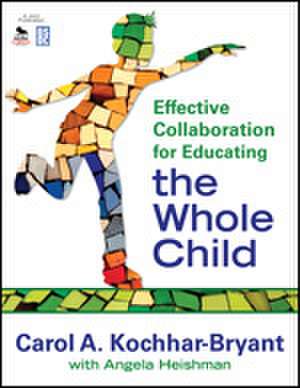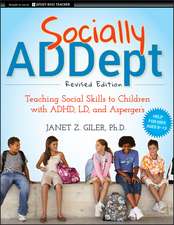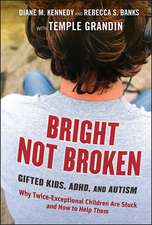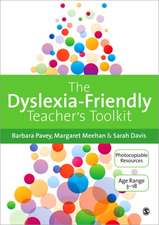Effective Collaboration for Educating the Whole Child
Editat de Carol A. Kochhar-Bryant, Angela S. Heishmanen Limba Engleză Paperback – 2 aug 2010
- Discusses the roles, responsibilities, and relationships between school professionals, community agencies, and service providers
- Offers case examples in each chapter as windows into schools and classrooms
- Emphasizes important developmental transitions from the primary years through secondary school and after
- Presents personal reflections from parents, students, and professionals
Developmentally responsive school environments depend on constructive relationships between the adults in a student's life, making this a vital resource for anyone who interacts with children.
Preț: 336.46 lei
Nou
64.38€ • 70.15$ • 54.25£
Carte tipărită la comandă
Livrare economică 23 aprilie-07 mai
Specificații
ISBN-10: 1412965276
Pagini: 280
Dimensiuni: 216 x 279 x 18 mm
Greutate: 0.77 kg
Ediția:1
Editura: SAGE Publications
Colecția Corwin
Locul publicării:Thousand Oaks, United States
Recenzii
"This book woke me up to many possibilities for collaboration and coordination within my school and community. It helped me view the whole picture and see the school as just a part of that picture. The book provides the ‘how-to’ that folks are looking for. The author identifies the purpose, points out the players, backs the purpose with research and specific success stories, breaks the how-to into bite-size pieces, and assures the reader that success can happen at any school."
"It is important for educators, and future educators, to understand how collaboration affects all individuals in and out of the educational setting. This book makes a distinct contribution to the field because it clarifies the importance of how and why collaboration will affect student learning and academic achievement."
"As educators strive to focus on the whole child, we are called on to join forces with families, community agencies, and other school professionals to address the cognitive, social-emotional, physical, and ethical development of students. This book comprehensively describes the characteristics of effective collaborative teams for educating the whole child, how to create them, and how to make them successful."
"The authors eloquently capture the tasks and interconnections of school and community professionals who share the responsibility of developing healthy environments so that all children have the opportunity to learn. This text presents models of school collaboration and agency coordination and real-life strategies for veterans and novices. Of utmost importance is that the tools discussed are for students with disabilities as well as those who might not meet the criteria to receive special education services but who require additional supports to experience success."
"A long-overdue response to a critical issue in our schools—that one size does not fit all—coupled with the need to educate the whole child. Finally, a practical look at how professionals from different disciplines can work together and blend their skills and talents to address the developmental needs of all students."
"This book is full of wonderful ideas that can easily be implemented in any school counseling program. A must for counselors preparing to go into schools to make a difference for every child they work with. I can't think of any text that could be more useful for teachers and counselors."
"A very timely book on an extremely important subject. Much of the emphasis on education in the past decade has shifted too far in the direction of standards and accountability to the detriment of educating the whole child. This book clearly articulates the need to revisit educational philosophy and practice in American public education and provides excellent guidelines and information on how to accomplish educating the whole child."
Cuprins
Acknowledgments
About the Author
About the Contributor
1. What Does It Mean to Educate the Whole Child?
Chapter Topics
Introduction: The New Face of Diversity
Collaboration Makes Pioneers of Us All
Dance of Development: The Paradox of Educating Children Who Develop at Different Rates
What Does It Mean to Educate the Whole Child?
What Is Collaboration, and Why Is It Important for Educating the Whole Child?
What Is Developmentally Responsive Practice?
How Do Environment and Health Status Affect Learning and Development?
How Does Social-Emotional Health Affect Learning and Development?
How Does Participation in High-Risk Behavior Affect Learning and Development?
What Is the Family's Role in Promoting the Development of the Whole Child?
An Imperative to Celebrate Our Work
Closing
Summary of Key Points
Key Terms and Phrases
2. What Is a Developmentally Healthy School Environment?
Chapter Topics
Introduction
What Is the Relationship Between Social and Emotional Health and Learning?
What Are the Characteristics of a Developmentally Healthy School Environment?
Ten Strategies That Promote a Developmentally Responsive School Environment
What Models and Initiatives Exist for Creating Developmentally Responsive School Environments?
Closing
Summary of Key Points
Key Terms and Phrases
3. What Laws Promote Collaboration for the Whole-Child Initiative?
Chapter Topics
Introduction
Is the Whole-Child Initiative New?
What Laws Support Professional Collaboration to Educate the Whole Child?
Summary of Key Points
Key Terms and Phrases
4. How Do Schools Create Developmentally Responsive Environments? A Shared Responsibility
Chapter Topic
Introduction
What Are the Typical Roles of School Personnel, and How Can They Be Expanded to Address the Needs of Students?
Closing: Toward a Culture of Collaboration
Summary of Key Points
Key Terms and Phrases
5. How Do Professionals Collaborate to Educate the Whole Child?
Chapter Topics
Introduction
Why Is There a Growing Interest in Collaboration to Address the Developmental Needs of the Whole Child?
How Does Collaboration Lead to Schoolwide Change?
The Many Uses of Collaboration: The Four Action-Dimensions
Is Collaboration a Developmental Process?
Collaboration in the Early Years
Collaboration in the Middle Years
Collaboration in High School Years
Ten Principles for Successful Collaboration and Coordination
Summary of Key Points
Key Terms and Phrases
6. What Is the Role of Community Agencies?
Chapter Topics
Introduction
How Do Coordinated Services Support Developmentally Responsive School Environments?
What Community Agencies Should Be Engaged With Schools?
How Do Schools and Community Agencies Work Together?
How Do Schools and Community Agencies Coordinate for Youth Placed at Risk?
How Is an Interagency Agreement Developed?
What Is the Role of the Local Interagency Planning Council?
Summary of Key Points
Key Terms and Phrases
7. How Does Cultural and Linguistic Diversity Affect Professional Collaboration?
Chapter Topics
Introduction
Who Are Culturally and Linguistically Diverse Students and Families?
What Is Cultural Diversity?
How Does Cultural and Linguistic Diversity Enrich School Environments?
How Does Cultural and Linguistic Diversity Affect Professional Collaboration?
What Strategies Are Effective for Working With CLD Students and Parents?
Eight Principles and Strategies to Strengthen Professional Collaboration in Highly Diverse Schools
Summary of Key Points
Key Terms and Phrases
8. Celebrating Our Work: What Are the Benefits and Positive Impacts of Professional Collaboration
Chapter Topics
Introduction
The Power of Collaboration: Can the Success of Professional Collaboration and Interagency Coordination Be Measured?
Does Professional Collaboration Improve Results for the Whole Child?
How Do We Know That Whole-Child Approaches Impact Studet Learning?
Does Collaboration Promote Student and Family Self-Determination?
Why Is it Important to Celebrate Our Work and Renew Our Commitment?
Closing: A Call to Action
Summary of Key Points
Key Terms and Phrases
References
Index
Notă biografică
Carol Kochhar-Bryant is a professor of special education at the George Washington University. For 21 years she has developed and directed advanced graduate and doctoral leadership preparation programs related to secondary and transition services for youth with disabilities. She teaches courses in special education, legal issues and public policy, systemic change and leadership, and interdisciplinary planning and development. She currently consults with public school districts, state departments of education, and federal agencies, and has collaborated in international special education and transition policy research with the World Bank and the Office of Economic Cooperation and Development. She has conducted evaluations of state systemic reform initiatives, national technical assistance centers, transition services in correctional systems, and a variety of community-based agencies. Kochhar-Bryant is a former teacher of individuals with intellectual disabilities, a residential program director, case management program director, and evaluator. She is widely published in the areas of disability policy, leadership development, interagency service coordination, career-vocational programming, and secondary-to-postsecondary transition for special learners. She is past president of the Division on Career Development and Transition of the International Council for Exceptional Children.












